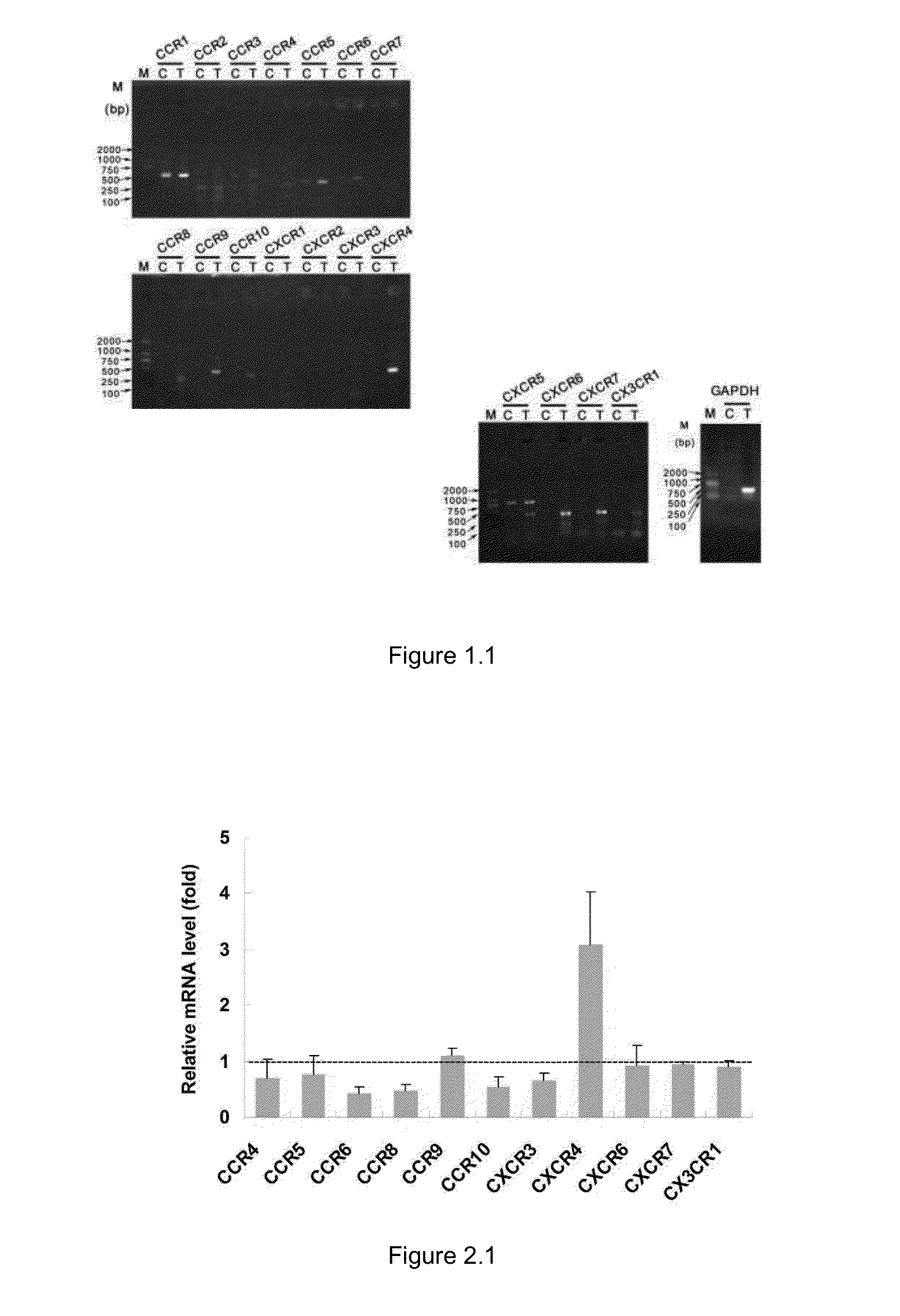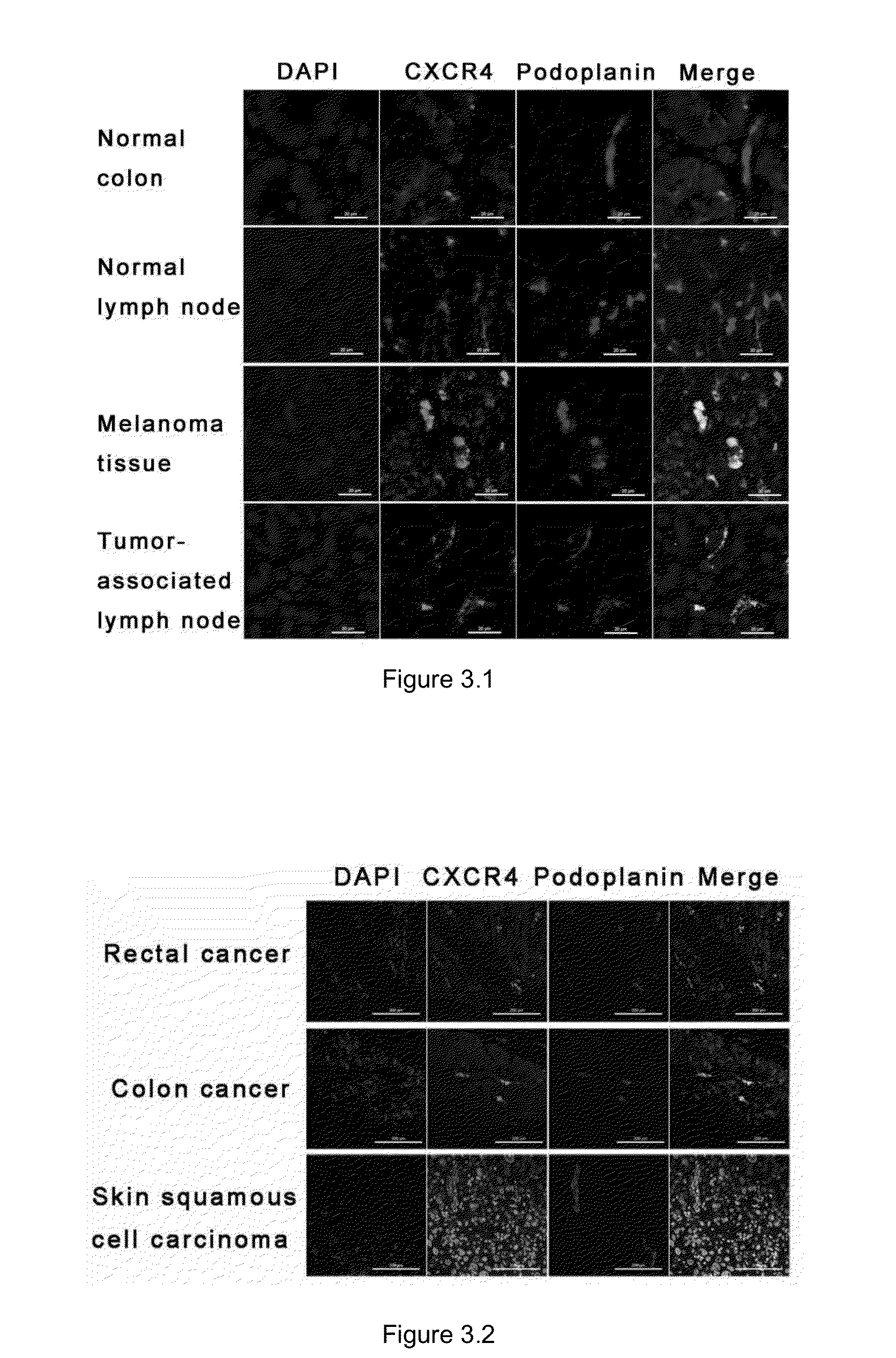Method and medicament for inhibiting lymphangiogenesis
- Summary
- Abstract
- Description
- Claims
- Application Information
AI Technical Summary
Benefits of technology
Problems solved by technology
Method used
Image
Examples
example 1
Lymphatic Endothelial Cells Express a Variety of Chemokine Receptors
Methods
[0070]1. Extraction of Total RNA from Cells and Detection of Chemokine Receptor Expression in Lymphatic Endothelial Cells by RT-PCR
[0071]The isolation and extraction of total RNA from cells was performed using TRIZOL reagent (purchased from Invitrogen) following the standard operations as described in the reagent instructions. 1 mL of TRIZOL was added to the primary lymphatic endothelial cells (about 1×106) collected by centrifugation, repeatedly pipetted up and down for 30 times, and then set aside at room temperature for 5 minutes. After centrifugation at 10,000×g at 4° C. for 15 minutes, the supernatant was removed gently. 0.2 mL of chloroform was added to the supernatant, vortexed vigorously for about 15 seconds, and then set aside at room temperature for 3 minutes. After centrifugation at 10,000×g at 4° C. for 15 minutes, the sample was stratified into three layers, i.e., a yellow organic phase, an inter...
example 2
Chemokine Receptor CXCR-4 is Highly and Specifically Expressed on VEGF-C-Activated Lymphatic Endothelial Cells
Methods
1. Detection of the Expression of the Chemokine Receptors on Lymphatic Endothelial Cells by RT-PCR
[0075]Fluorescence Quantitative Real-Time PCR was performed using a kit from Stratagene (Brilliant II SYBR® Green QRT-PCR Master Mix). The fluorescence quantitative PCR instrument was MX3000P (purchased from Stratagene), the fluorescence dye was SYBR Green, the volume of the reaction system was 20 μL, and the cycle number of the reaction was 40. GAPDH was used as an internal control. The ΔCt value was obtained from the fluorogram provided by the instrument, and the relative Δ(ΔCt) value was calculated, thereby calculating the relative change in the level of the corresponding gene.
2. Verification of Vascular Endothelial Growth Factor C (VEGF-C)-Induced Expression of Chemokine Receptor CXCR4 on the Surface of Lymphatic Endothelial Cells by Flow Cytometry
[0076]Mouse primary ...
example 3
CXCR4 is Highly and Specifically Expressed on the Surface of Newly Formed Lymphatic Vessels In Vivo
Methods
1. Detection of the Distribution of Chemokine CXCR4 on Lymphatic Vessels In Vivo by Tissue Immunofluorescence
[0089]Eight healthy C57BL / 6 mice (6-8 weeks old, female, purchased from Vital River Laboratories, Beijing) were divided into two groups, one of which includes three mice normally fed, and the other includes five tumor-bearing mice intracutaneously inoculated with 5×106 B16 / F10 mouse melanoma cells (American Type Culture Collection, ATCC). 14 days after inoculation, the tumor tissues and peritumoral axillary lymph node tissues were removed from the tumor-bearing mice, and the colon tissues and lymph node tissues were removed from the normal mice.
[0090]Fixing and embedding: The removed tissues were fixed with 4% formaldehyde solution overnight, and then rinsed with tap water overnight to completely wash off formaldehyde (the tissue blocks could be wrapped with gauze, placed...
PUM
 Login to View More
Login to View More Abstract
Description
Claims
Application Information
 Login to View More
Login to View More - R&D
- Intellectual Property
- Life Sciences
- Materials
- Tech Scout
- Unparalleled Data Quality
- Higher Quality Content
- 60% Fewer Hallucinations
Browse by: Latest US Patents, China's latest patents, Technical Efficacy Thesaurus, Application Domain, Technology Topic, Popular Technical Reports.
© 2025 PatSnap. All rights reserved.Legal|Privacy policy|Modern Slavery Act Transparency Statement|Sitemap|About US| Contact US: help@patsnap.com



